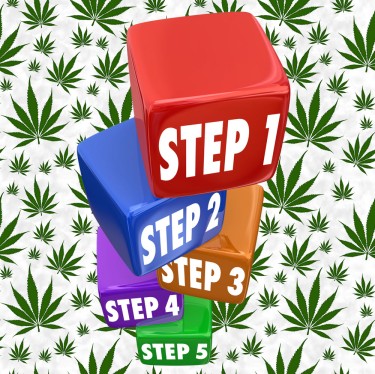
Despite some critics of marijuana reform challenging the review process that led federal health officials to recommend rescheduling cannabis, the Drug Enforcement Administration (DEA) is now recognizing the validity of the new two-part test used to determine a substance’s accepted medical use.
This acknowledgement was included as a footnote in a notification on Tuesday about a decision to categorize two synthetic opioid medicines under Schedule I of the Controlled Substances Act (CSA), which had nothing to do with the original decision.
A Schedule I substance is one that has no contemporary recognized medical use (CAMU), according to federal law. In the past, the government has used a five-part test to determine if a chemical satisfies this requirement by looking at its chemistry, health statistics, and other pertinent details. However, earlier this year, the Department of Health and Human Services (HHS) introduced a simplified two-step analysis when reviewing the proposed rescheduling of marijuana, ultimately concluding that cannabis should be placed in Schedule III.
The New Two-Part Test for Determining Medical Use
The newly adopted two-part test introduced by the Department of Health and Human Services (HHS) focuses on two fundamental questions when determining whether a substance has an accepted medical use. First, it asks whether licensed healthcare providers currently use the substance in medical treatment within jurisdictions where such use is legally authorized. Second, it examines whether there is credible scientific evidence supporting the drug’s efficacy for at least one recognized medical condition.
This streamlined approach stands in stark contrast to the previous five-part test, which required a more complex and detailed evaluation of a substance’s chemistry, safety data, clinical efficacy, expert consensus, and the availability of published scientific studies. The older model was seen as more restrictive, often limiting substances from being considered for rescheduling despite emerging evidence of their therapeutic benefits.
The novel examination stands out for its ability to lower administrative obstacles and provide a simpler means by which drugs such as cannabis can be reassessed in light of current scientific research and practical medicinal uses. In spite of the lack of FDA clearance, the two-part exam recognizes the increasing acceptability of some medications in clinical practice by emphasizing their practical medical usage in legally permitted circumstances.
In a footnote to its latest scheduling notice, the Drug Enforcement Administration (DEA) admitted that the Department of Justice's Office of Legal Counsel (OLC) deemed the standard five-part criteria "impermissibly narrow." The OLC also stated that the simplified two-part examination is adequate to assess if a medicine has a genuine medical purpose, emphasizing that FDA clearance should not be the main factor in rescheduling decisions. During the rescheduling process, the DEA must now defer to the HHS's scientific and medical determinations, representing a substantial shift in how federal agencies approach restricted drug regulation.
This novel technique may have far-reaching repercussions beyond marijuana. With increasing interest in the medicinal potential of psychedelics such as psilocybin and MDMA, the streamlined test may also facilitate the categorization of these compounds. If healthcare practitioners can establish medicinal usage in certain areas and back it up with reputable scientific research, these drugs may benefit from the less stringent regulation procedure that now applies to cannabis.
Resistance and Criticism of the Two-Part Analysis
The implementation of the two-part study has aroused strong protest from marijuana rescheduling opponents, who claim that the new criterion is unreasonable and politically driven. Some opponents argue that the simplified test was designed to enable a predetermined conclusion supporting cannabis reform rather than being based on strong scientific considerations.
One prominent prohibitionist group, Smart Approaches to Marijuana (SAM), has labeled the two-part analysis a “novel test” that was “recently invented by HHS and embraced” as a means to move marijuana into Schedule III. SAM and similar groups argue that the simplified framework lacks the rigor of the former five-part test, accusing policymakers of shaping the new approach to fit a political agenda.
Some legal experts believe that challenging the validity of the two-part test could become a central argument in any legal contest against the rescheduling of marijuana. Opponents may attempt to undermine the process by claiming that the test is an arbitrary departure from established regulatory practices, designed solely to ease the path for marijuana reform.
Despite this criticism, the DEA’s recent scheduling notice for two synthetic opioid drugs—N-pyrrolidino metonitazene and N-pyrrolidino protonitazene—suggests that the agency views the two-part analysis as legitimate. The acknowledgment of the new test in unrelated drug scheduling decisions could signal that the DEA is fully committed to using this simplified framework moving forward, which may complicate efforts to challenge it.
Implications for Future Drug Scheduling Decisions
Beyond only moving the legalization of marijuana, the DEA's support of the new two-part exam may have a big impact on how future drug tests for other substances—like psychedelics—will be conducted. The streamlined test may offer a more accommodating framework for evaluating the medicinal use of substances like psilocybin, MDMA, and LSD in contexts where they are permitted by law, as interest in their therapeutic potential develops.
The DEA is expected to use the same two-part approach if these compounds are subject to review; the focus will be on the substances' present medicinal use and the availability of reliable scientific backing. This change might lead to the reclassification of psychedelics, particularly because ongoing clinical research indicate that they can effectively treat diseases including anxiety, PTSD, and depression.
The widespread adoption of this reduced technique suggests a possible change in federal drug policy away from the normally strict five-part examination. The two-part test may allow for a more science-driven and practical assessment of developing medicines, increasing access to alternative treatments.
While the rescheduling of marijuana is still being reviewed, the DEA plans to have an administrative hearing in December 2024 to gather further feedback before making a final rule. The process might last until early 2025, allowing the next presidential administration to decide the future of drug policy, including how the two-part test is applied to additional substances.
Bottom Line
The DEA's endorsement of a simplified two-part test to determine the medical use of substances, which was recently applied to marijuana rescheduling, represents a significant shift in federal drug policy. This new framework focuses on current medical use and credible scientific evidence, bypassing the more stringent five-part test previously used. While critics argue that the new test is politically motivated, it could open the door to reclassifying other substances like psychedelics, offering a more practical and science-driven approach to drug scheduling decisions.







